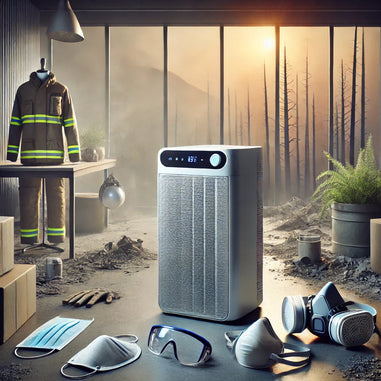- No products in the cart.
It’s crucial that health care workers, emergency responders, and staff at hazardous waste plants and those who work at nuclear power plants always assess any potential risks that could be present in their environment to ensure that they’re protecting themselves or others to the fullest extent. In some instances, this means wearing personal protection such as a hazmat suit to prevent exposure to hazardous contaminants. A hazmat suit can mean the difference between life and death.
What is a Hazmat Suit?
A hazmat suit is known as a form of personal protection made to safeguard the user from hazardous material such as chemicals, radioactive material, and biological agents. This protective gear is usually worn by firefighters, paramedics, researchers, or emergency medical crew who are exposed to toxic or contaminated environments.

How Does a Hazmat Suit Work?
Hazmat suits protect against nuclear, hazardous chemical, and biological agents as well as fire, and high temperatures. These suits vary depending on the risk level.
Hazmat suits are gas-tight so that users will not have any exposure to or breathe in dangerous chemicals or substances. Depending on the material of the hazmat suit, some suits can be exposed to high temperatures.
These suits also have suppliers for air to ensure the wearer is breathing uncontaminated air. One way to supply air is with the use of SCBA which stands for self-contained breathing apparatus. These can typically be worn in or outside of the suit.
What are the Different Levels of Hazmat Suits?
Hazmat suits are categorized by level and are associated with the protection they offer. The following are the four levels:
Level A. This category of hazmat suits is vapor tight and provides a high level of protection from direct and airborne chemical contact. They protect against gases, mists, splashes, and vapors. They are typically worn with a self-contained breathing apparatus enclosed within the suit. These suits include a gas-tight suit, a positive pressure SCBA, chemical resistant inner & outer gloves, and chemical resistant boots with a steel toe and midsole.
Level B. Level B hazmat suits are not vapor-tight. They are, however, worn with an SCBA. This protective garment provides protection against hazardous chemical splashes but not vapor or gases. Level B suits require an SCBA, chemical resistant clothing, gloves, and boots with a steel midsole and toe.
Level C. This category includes coveralls or splash suits and is usually worn with a respirator or gas mask. Most firefighters wear Level C protective gear. These suits protect against hazardous chemicals and airborne substances. Gear also includes a hard hat and disposable chemical-resistant outer boots.
Level D. Level D does not require a hazmat suit but specific work clothing and eye splash protection. This level is usually worn when there is no danger to workers from chemical exposure. This category includes a pair of coveralls and chemical-resistant footwear with a steel midsole and toe.
Types of Hazmat Suits
Hazmat suit types range from Type 1 to Type 6. These types of suits provide protection from the following:
Type 1 - Hazardous material, explosives, and chemicals
Type2 - Flammable gases and liquids
Type 3 - Splashes, sprays, and acids
Type 4 - Dyes, crude oil, petroleum, and machine oil
Type 5 - Airborne particulates
Type 6 - Dust, dirt, and airflow
Are Hazmat Suits Reusable?
Hazmat suits can be disposable or reusable. Since sustainability is becoming a major issue in our environment it’s nice to have both types of suits on hand. Of course, if the suit itself becomes contaminated, then the suit must be disposed of immediately and in the proper way.
Some hazmat suits are reusable if designed that way. Even though they are more expensive to buy upfront, they do last for a longer period of time so you can get more use out of the reusable suits.
Reusable suits are also more expensive because they are designed with stronger material, therefore, costing more upfront. Reusable suits can be used frequently and efficiently under the proper conditions. The biggest difference between disposable and reusable suits is the cost.
How Much Does a Real Hazmat Suit Cost?
Sometimes buying in bulk can be more economical. Never compromise the health or safety of anyone in this type of environment. Your protection or the protection of your staff is worth every penny.
Lab Pro offers a large variety of Hazmat suits for all types of environments. For over 40 years, Lab Pro Inc. has been committed to delivering the highest quality chemicals, lab equipment, distance learning kits, lab supplies, and cleanroom PPE apparel to medical device companies and laboratories worldwide. To learn more, visit the biggest Lab Supply showroom in California, or contact us online or at 888-452-2776.













































are there any hazmath suits for animal dander protection. I am a person with HIGHLY dangerous allergies to people who have cats. the dander_ will transport on their belongings, etc…so i need a suit if someone who has a cat comes to my house. is there any suit for this issue?